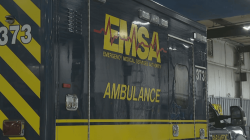A significant number of Americans are seeing their access to essential healthcare services diminish as numerous initiatives aimed at maintaining public well-being face cuts. These reductions particularly impact state and local health agencies tasked with crucial yet often unnoticed duties such as overseeing restaurant hygiene standards, tracking disease-causing pathogens in sewage systems, managing epidemic responses, and implementing various protective measures for individual citizens and society at large. This erosion leaves these vital organizations weakened.
The
Trump
Experts claim that the administration is reducing healthcare expenditures to an unparalleled degree. They have withdrawn $11 billion in direct federal funding and axed 20,000 positions at national health organizations that assist local public health efforts. Additionally, they are suggesting further cuts amounting to billions more.
Health officials have stated that these budget reductions are causing the whole public health framework to dwindle significantly compared to its former state and posing risks to basic operations — all amid national concerns about outbreaks of illnesses such as measles, pertussis, and avian influenza.
These actions indicate a move away from the concept of public health: undertaking tasks that no single person can accomplish individually to protect the entire community.
Below are key points from The Associated Press’ investigation into the impact of federal reductions to public health services on various communities and individuals throughout the United States.
The prevention of disease goes unnoticed—and often overlooked.
The efforts in prevention are subtle. It’s hard to pinpoint those who were protected since, ideally, individuals remain unaware when they have thwarted a life-threatening danger using the unseen barrier of public health measures.
For instance, the health department in Mecklenburg County, North Carolina, operates a mobile clinic that visits high schools to make sure students have received their necessary vaccinations against diseases such as measles and polio. These immunizations not only protect individual students but also benefit the broader community when sufficient numbers of individuals get vaccinated.
U.S. public health agencies operate initiatives aimed at decreasing suicide rates and drug overdose incidents, enhancing prenatal care, and assisting individuals in quitting smoking. They also provide education on various health topics and conduct testing and treatment for illnesses like
HIV
And tuberculosis. Some, such as Mecklenburg, also run medical and dental clinics.
Experts have determined that the operations of these government agencies are also economically efficient. For each dollar invested in childhood vaccinations, the nation reportedly saves $11; for smoking cessation programs, $2 to $3; and for managing asthma, approximately $70.
Chaos in
Washington
puts ‘lives at risk’
State and local health agencies rely heavily on financial assistance and backing from the federal government. Approximately 80 percent of the funds allocated by the U.S. Centers for Disease Control and Prevention are directed towards state and community levels, where they also provide guidance and additional resources to these entities.
When the Trump administration withdrew $11 billion from state and local health departments unexpectedly in March, followed by laying off numerous employees at the CDC just a week after, public health officials stated that these reductions dealt a significant setback to communities nationwide.
All eight workers involved in the mobile vaccination initiative in Mecklenburg have been terminated. In Columbus, Ohio, nine disease intervention specialists also lost their jobs as the department shifted focus to tackle an impending measles outbreak.
Nashville
was forced to discontinue a service providing complimentary flu and coronavirus testing.
At the same time, tobacco hotlines, early intervention services for children with hearing impairments, and initiatives aimed at preventing drownings are experiencing disruptions across various states and localities due to layoffs within the CDC teams.
A representative from the U.S. Department of Health and Human Services stated that HHS is restructuring certain “dysfunctional systems.” They also dismissed the suggestion that HHS has ignored pressing health risks.
HHS justified the grant cancellations by saying the money was for COVID and the pandemic is over. But most of the cuts were in areas that are especially important given today’s health threats, including epidemiology and laboratory capacity as well as immunizations.
Connecticut’s state health commissioner told a Democratic congressional hearing the current uncertainty “puts lives at risk.”
Public health funding is heading for bankruptcy — and things are set to deteriorate further.
The recent reductions have particularly severe consequences since health departments receive funding distinct from other governmental bodies designed to safeguard the populace: During crises, financial support surges but dwindles significantly once these events taper off. Leaders in public health frequently draw comparisons to fire departments, which maintain constant readiness unlike their counterparts who must hurriedly assemble resources like personnel and equipment only after an emergency has erupted.
During the pandemic, an influx of funds enabled certain health agencies to broaden and reinforce their initiatives. However, by the start of this year, much of that financial support had vanished, mirroring the fate of many other coronavirus-related subsidies nationwide—some ceased naturally, others were withdrawn by the authorities. Consequently, these organizations found themselves once more fragile and exposed.
In Chicago, emergency COVID funds constituted 51% of the health department’s budget, but with these grants coming to an end, staffing levels will drop below what they were before the pandemic. This reduction will hinder the ability to respond swiftly to disease outbreaks and may necessitate scaling down initiatives related to food safety, violence prevention, and more.
In Mecklenburg, the department shed 180 employees due to the depletion of COVID relief funds. Additionally, they terminated their wastewater surveillance collaboration with the University of North Carolina.
Charlotte
This enabled the country to respond swiftly to evolving COVID variants and could have also been utilized to identify new threats such as avian influenza.
The reductions have not concluded yet.
The Trump administration has suggested reducing the CDC’s budget by several billion dollars, which would potentially slash the agency’s expenditures by half. The CDC typically allocates roughly 80 percent of its funding to state and local governments.
Health officials caution that continuous budget reductions have left agencies ill-equipped to tackle emerging pandemics and resurgent old ailments throughout the United States.
___
Ungar covered stories from Charlotte and Louisville, Kentucky, while Smith reported from Providence, Rhode Island. Contributions to this report were made by Associated Press journalists Mary Conlon in Washington and Kenya Hunter in Atlanta.
Independent readers are free-thinking global citizens who aren’t categorized by conventional demographics or labels; instead, they’re characterized by their perspectives. In our ever-more segmented society, communities cherish genuine facts and honest viewpoints shared directly through an impartial news source they find reliable. Empowered and motivated by this knowledge and encouragement, independent readers feel ready to advocate for what they hold dear.







